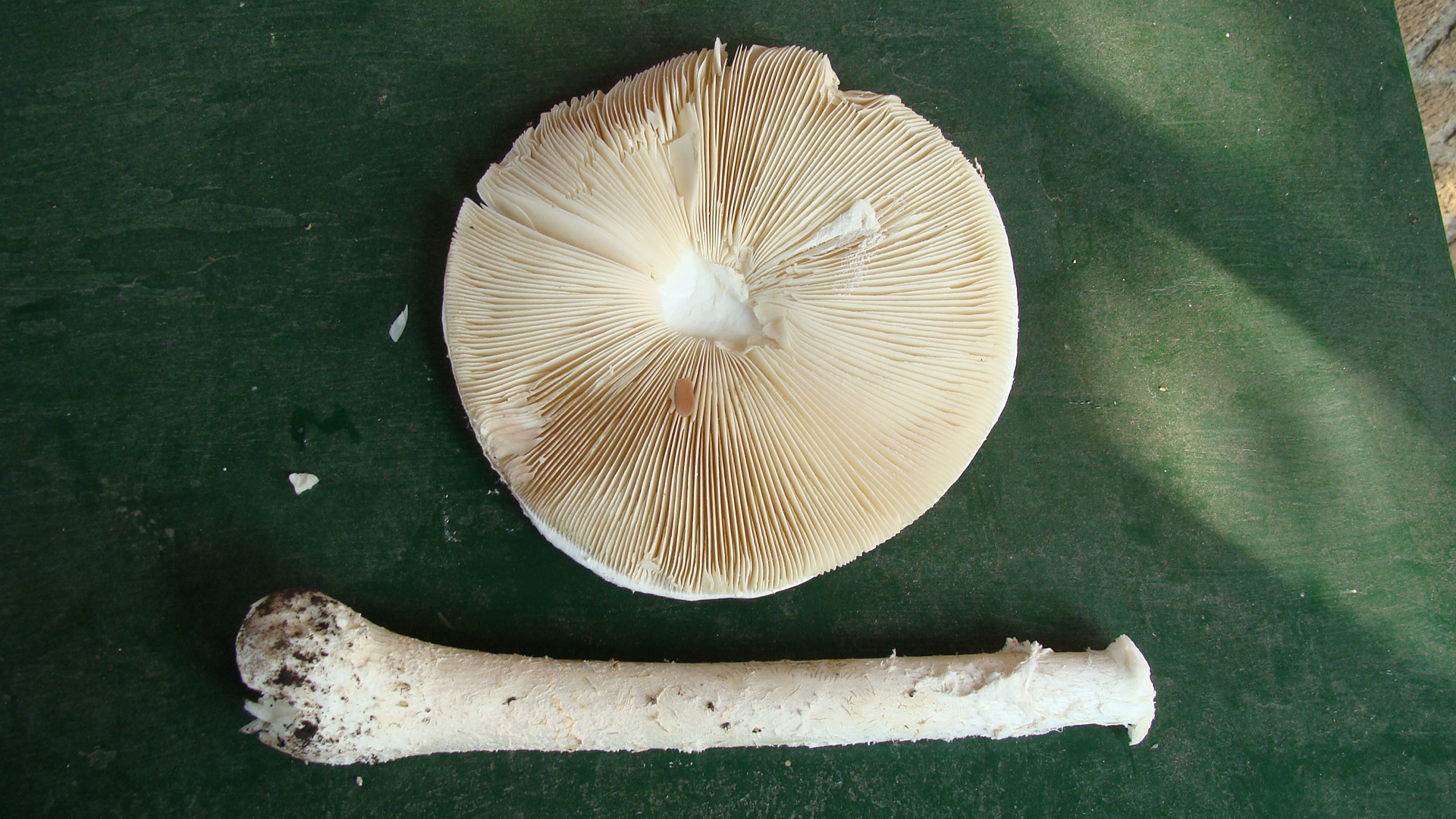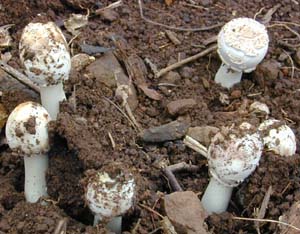|
Amanita Smithiana
''Amanita smithiana'', also known as Smith's amanita, is a species of agaric found on soil in coniferous (''Abies'', ''Tsuga'', ''Pseudotsuga'') and broadleaved (''Alnus'', ''Quercus'') woodland in the Pacific Northwest of North America. It fruits in August and September. Description The cap has a diameter of and is white and scaled with remnants of the universal veil. The stipe is long by thick, white and similarly scaled, with a ring. The spores are ellipsoid to elongated, amyloid, and measure 11–12.5 by 7–8 μm. Taxonomy ''Amanita smithiana'' was described by Dutch mycologist Cornelis Bas in 1969. The specific epithet honors mycologist Alexander H. Smith, who collected the type specimens from Washington in 1941. It belongs in the subgenus ''Lepidella''. Toxicity It is responsible for poisonings in the Pacific Northwest when mistaken for the edible and sought after ''Tricholoma murrillianum'' (matsutake). It causes initial gastrointestinal symptoms that ... [...More Info...] [...Related Items...] OR: [Wikipedia] [Google] [Baidu] |
Cornelis Bas
Dr. Cornelis (Kees) Bas (1928 – 10 February 2013) was a Dutch mycologist. Dr. Bas was born in Rotterdam and graduated in Biology at Leiden University in 1954. In 1953, he began working at the National Herbarium of the Netherlands, as curator for the fungi, in particular, the Agaricales. Early in his career he played an important role in modernizing the collections of Dutch and European European, or Europeans, may refer to: In general * ''European'', an adjective referring to something of, from, or related to Europe ** Ethnic groups in Europe ** Demographics of Europe ** European cuisine, the cuisines of Europe and other West ... higher fungi. He died on 10 February 2013. References 1928 births 2013 deaths Dutch mycologists Leiden University alumni Scientists from Rotterdam {{Netherlands-scientist-stub ... [...More Info...] [...Related Items...] OR: [Wikipedia] [Google] [Baidu] |
Species Description
A species description is a formal scientific description of a newly encountered species, typically articulated through a scientific publication. Its purpose is to provide a clear description of a new species of organism and explain how it differs from species that have been previously described or related species. For a species to be considered valid, a species description must follow established guidelines and naming conventions dictated by relevant nomenclature codes. These include the International Code of Zoological Nomenclature (ICZN) for animals, the International Code of Nomenclature for algae, fungi, and plants (ICN) for plants, and the International Committee on Taxonomy of Viruses (ICTV) for viruses. A species description often includes photographs or other illustrations of type material and information regarding where this material is deposited. The publication in which the species is described gives the new species a formal scientific name. Some 1.9 million ... [...More Info...] [...Related Items...] OR: [Wikipedia] [Google] [Baidu] |
Amanita Proxima
''Amanita proxima'' is a species of Amanita The genus ''Amanita'' contains about 600 species of agarics, including some of the most toxic known mushrooms found worldwide, as well as some well-regarded Edible mushroom, edible species (and many species of unknown edibility). The genus is re ... from France, Italy, and Spain. It is poisonous. References External links * * proxima Fungus species {{Amanitaceae-stub ... [...More Info...] [...Related Items...] OR: [Wikipedia] [Google] [Baidu] |
Saproamanita Thiersii
''Saproamanita thiersii'' (formerly ''Amanita thiersii''), commonly called Thiers' lepidella, is a North American saprotrophic basidiomycete fungus in the genus ''Saproamanita''. It is a white, small mushroom. Its Pileus (mycology), cap is convex, measuring across, and the Stipe (mycology), stipe is long. The spore print is white. Originally described from Texas but today found in ten states of North America, the mushroom grows in lawns, pastures and prairies. It is a Saprotrophic nutrition, saprotroph, living on decaying plant material, and not mycorrhizal as is the case with species of ''Amanita'', where it was previously placed. Fruit bodies appear during July and August, either in isolation or in groups, and often form fairy rings. A genome sequencing project aims to study the cellulose decomposition capabilities of the fungus. It is probably Mushroom poisoning, poisonous. Taxonomy ''Sapromanita thiersii'' was first species description, described in 1957 by American m ... [...More Info...] [...Related Items...] OR: [Wikipedia] [Google] [Baidu] |
Amanita Sphaerobulbosa
''Amanita sphaerobulbosa'', commonly known as the Asian abrupt-bulbed Lepidella, is a species of agaric fungus in the family Amanitaceae. First described by mycologist Tsuguo Hongo in 1969, it is found in Southern Asia. The fruit bodies of ''A. sphaerobulbosa'' are damaging to the liver; the toxicity is thought to be largely due to a rare amino acid. Although not considered as toxic as its deadly relatives (e.g. the death cap and the destroying angel), ''A. sphaerobulbosa'' is thought to have caused fatalities. Poisoning symptoms include abrupt violent vomiting, diarrhea and dehydration after a delay of 10–20 hours. Description Biochemistry Several novel unusual amino acids have been isolated from ''Amanita sphaerobulbosa'', including (2''S'',4''Z'')-2-amino-5-chloro-6-hydroxy-4-hexenoic acid; D,L-2-amino-4-pentynoic acid (0.257% w/w); and L-2-amino-4,5-hexadienoic acid (0.911% w/w). These last two chemicals are suspected to be largely responsible for the toxic effe ... [...More Info...] [...Related Items...] OR: [Wikipedia] [Google] [Baidu] |
Hemodialysis
Hemodialysis, American and British English spelling differences#ae and oe, also spelled haemodialysis, or simply ''"'dialysis'"'', is a process of filtering the blood of a person whose kidneys are not working normally. This type of Kidney dialysis, dialysis achieves the extracorporeal removal of waste products such as creatinine and urea and free water from the blood when the kidneys are in a state of kidney failure. Hemodialysis is one of three renal replacement therapy, renal replacement therapies (the other two being kidney transplant and peritoneal dialysis). An alternative method for extracorporeal separation of blood components such as plasma or cells is apheresis. Hemodialysis can be an outpatient or inpatient therapy. Routine hemodialysis is conducted in a dialysis outpatient facility, either a purpose-built room in a hospital or a dedicated, stand-alone clinic. Less frequently hemodialysis is done at home hemodialysis, home. Dialysis treatments in a clinic are initiated ... [...More Info...] [...Related Items...] OR: [Wikipedia] [Google] [Baidu] |
Nephritis
Nephritis is inflammation of the kidneys and may involve the glomeruli, tubules, or interstitial tissue surrounding the glomeruli and tubules. It is one of several different types of nephropathy. Types * Glomerulonephritis is inflammation of the glomeruli. Glomerulonephritis is often implied when using the term "nephritis" without qualification. * Interstitial nephritis (or tubulo-interstitial nephritis) is inflammation of the spaces between renal tubules. Causes Nephritis can often be caused by infections and toxins, but it is most commonly caused by autoimmune disorders that affect the major organs like kidneys. * Pyelonephritis is inflammation that results from a urinary tract infection that reaches the renal pelvis of the kidney. * Lupus nephritis is inflammation of the kidney caused by systemic lupus erythematosus (SLE), a disease of the immune system. * Athletic nephritis is nephritis resulting from strenuous exercise. Bloody urine after strenuous exercise may ... [...More Info...] [...Related Items...] OR: [Wikipedia] [Google] [Baidu] |
Tricholoma Murrillianum
''Tricholoma murrillianum'' is a species of mushroom-forming fungus found in North America also known as the ponderosa mushroom, pine mushroom, and Western matsutake. It produces a choice edible mushroom but can be confused with the poisonous '' Amanita smithiana''. Taxonomy It belongs to the genus ''Tricholoma'' in the matsutake species complex, which includes the closely related East Asian songi or matsutake as well as the American matsutake ('' T. magnivelare'') and Mexican matsutake ('' T. mesoamericanum''), found in southern North America. It was previously included with the American matsutake, '' T. magnivelare'', but in 2017 research based on molecular analysis separated the two and determined that ''T. magnivelare'' is limited to the eastern half of North America. Description It is a gilled mushroom, colored mostly white with hints of tan. It is ectomycorrhizal. The cap grows up to wide. The gills are very close. The stem is up to long with parti ... [...More Info...] [...Related Items...] OR: [Wikipedia] [Google] [Baidu] |
Edible Mushroom
Edible mushrooms are the fleshy fruit bodies of numerous species of macrofungi (fungi that bear fruiting structures large enough to be seen with the naked eye). Edibility may be defined by criteria including the absence of poisonous effects on humans and desirable taste and aroma. Mushrooms that have a particularly desirable taste are described as "''choice''". Edible mushrooms are consumed for their nutritional and culinary value. Mushrooms, especially dried shiitake, are sources of umami flavor. To ensure safety, wild mushrooms must be correctly identified before their edibility can be assumed. Deadly poisonous mushrooms that are frequently confused with edible mushrooms include several species of the genus ''Amanita'', particularly '' A. phalloides'', the death cap. Some mushrooms that are edible for most people can cause allergic reactions in others; old or improperly stored specimens can go rancid and cause food poisoning. Additionally, mushrooms can absor ... [...More Info...] [...Related Items...] OR: [Wikipedia] [Google] [Baidu] |
Mushroom Poisoning
Mushroom poisoning is poisoning resulting from the ingestion of mushrooms that contain toxicity, toxic substances. Signs and symptoms, Symptoms can vary from slight Gastrointestinal tract, gastrointestinal discomfort to death in about 10 days. Mushroom toxins are secondary metabolites produced by the fungus. Mushroom poisoning is usually the result of ingestion of wild mushrooms after misidentification of a Mycotoxin, toxic mushroom as an edible species. The most common reason for this misidentification is a close resemblance in terms of color and general Morphology (biology), morphology of the toxic mushrooms species with edible species. To prevent mushroom poisoning, mushroom gatherers familiarize themselves with the mushrooms they intend to collect, as well as with any similar-looking toxic species. The safety of eating wild mushrooms may depend on methods of preparation for cooking. Some toxins, such as amatoxins, are Thermostability, thermostable and mushrooms containing such ... [...More Info...] [...Related Items...] OR: [Wikipedia] [Google] [Baidu] |
Subgenus
In biology, a subgenus ( subgenera) is a taxonomic rank directly below genus. In the International Code of Zoological Nomenclature, a subgeneric name can be used independently or included in a species name, in parentheses, placed between the generic name and the specific epithet: e.g. the tiger cowry of the Indo-Pacific, ''Cypraea'' (''Cypraea'') ''tigris'' Linnaeus, which belongs to the subgenus ''Cypraea'' of the genus ''Cypraea''. However, it is not mandatory, or even customary, when giving the name of a species, to include the subgeneric name. In the International Code of Nomenclature for algae, fungi, and plants The ''International Code of Nomenclature for algae, fungi, and plants'' (ICN or ICNafp) is the set of rules and recommendations dealing with the formal botanical names that are given to plants, fungi and a few other groups of organisms, all tho ... (ICNafp), the subgenus is one of the possible subdivisions of a genus. There is no limit to the number of divisio ... [...More Info...] [...Related Items...] OR: [Wikipedia] [Google] [Baidu] |
Washington (state)
Washington, officially the State of Washington, is a U.S. state, state in the Pacific Northwest region of the United States. It is often referred to as Washington State to distinguish it from Washington, D.C., the national capital, both named after George Washington (the first President of the United States, U.S. president). Washington borders the Pacific Ocean to the west, Oregon to the south, Idaho to the east, and shares Canada–United States border, an international border with the Provinces and territories of Canada, Canadian province of British Columbia to the north. Olympia, Washington, Olympia is the List of capitals in the United States, state capital, and the most populous city is Seattle. Washington is the List of U.S. states and territories by area, 18th-largest state, with an area of , and the List of U.S. states and territories by population, 13th-most populous state, with a population of just less than 8 million. The majority of Washington's residents live ... [...More Info...] [...Related Items...] OR: [Wikipedia] [Google] [Baidu] |




